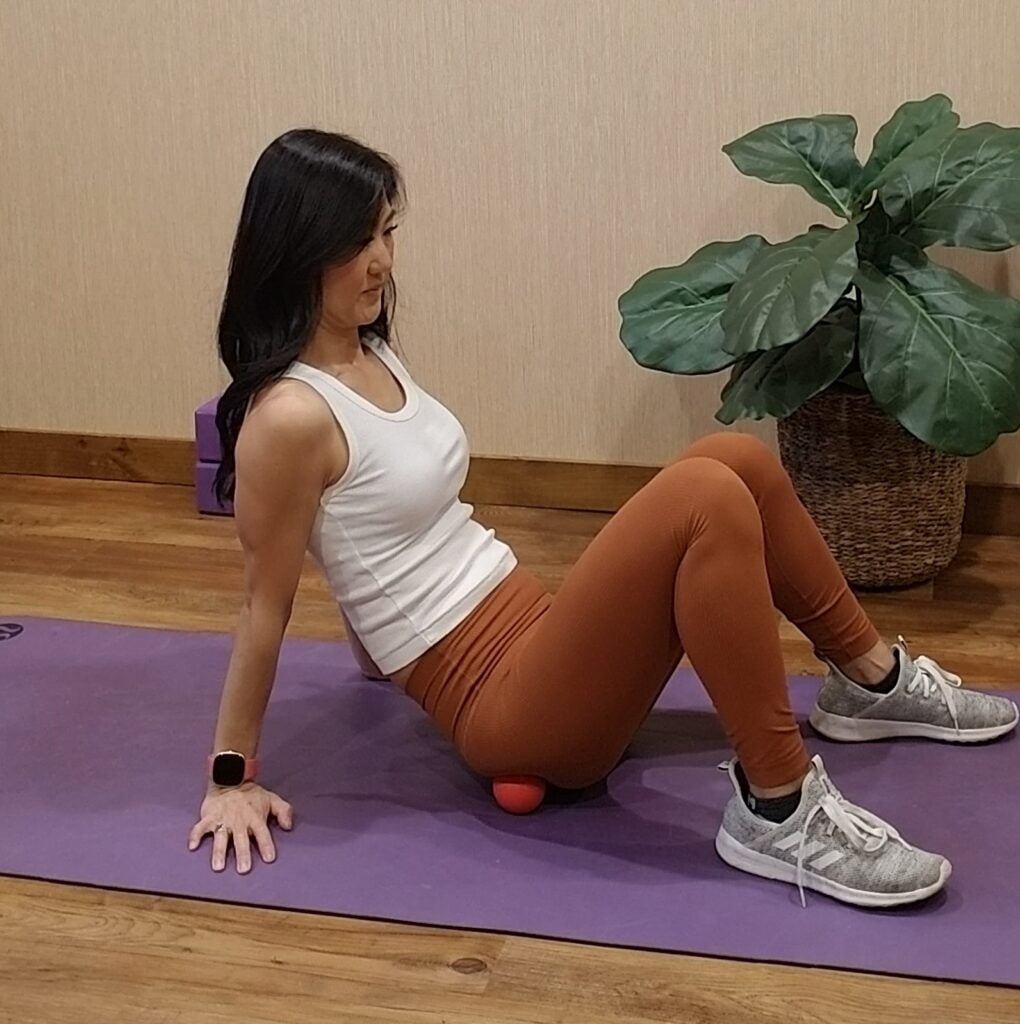The Best Tennis Ball Sciatica Exercises: Get Relief Fast!
Last Updated on April 18, 2024 by Dr. Tiffany Egan
A few years back when I was pregnant with my first baby I found it extremely difficult to deal with trigger points associated with my sciatica symptoms. It felt like the only thing that helped was seeing my prenatal massage therapist. Even though I would love to see her everyday while I was pregnant, lack of time and money made it impossible!
However, I found it very helpful to use a tennis ball or lacrosse ball instead to get very targeted pressure point relief in my glutes and piriformis muscles. Here are some of the best tennis ball sciatica exercises to help with your pain!
What is sciatica and how does it affect mobility?
Sciatica is a common condition that causes pain, numbness, and weakness in the lower back, buttocks, and legs. It occurs when the sciatic nerve, which runs from the lower back down the back of each leg, becomes compressed or irritated. This irritation of the sciatic nerve roots can result from various factors such as a herniated disc, spinal stenosis, muscle tightness or even pregnancy.
Sciatic pain can be debilitating, making it difficult to perform daily activities and negatively impacting mobility. Simple tasks like walking or sitting can become excruciatingly painful. Fortunately, there are ways to alleviate sciatica pain and regain mobility, and one effective method is through tennis ball sciatica exercises.
Understanding tennis ball sciatica exercises and their benefits
Tennis ball sciatica exercises involve using a tennis ball to target specific areas of the body affected by sciatica. Similar to a trigger point massage, the pressure applied by the ball helps release tension, reduce inflammation, and promote blood flow to the affected area. These exercises not only provide immediate relief but also help in the long-term management of sciatica.
The benefits of tennis ball sciatica exercises are multi-fold. Firstly, they help to relax tight muscles and relieve muscle spasms by stimulating trigger points in the lower extremities, which are common contributors to sciatica pain. Secondly, these exercises increase blood circulation, improve flexibility and range of motion, reducing the risk of future sciatica episodes.
Lastly, they promote the release of endorphins, the body’s natural painkillers, providing a natural and drug-free way to manage sciatica pain.
Tennis ball sciatica exercises for lower back pain relief
Lower back pain is one of the most common symptoms of sciatic nerve pain. To alleviate this pain, there are several tennis ball exercises you can try in the comfort of your own home.

Start by lying on your back with your knees bent and feet flat on the floor. Place a tennis ball under the lower back, targeting the painful area. Gently roll your body over the ball, allowing it to massage the muscles in your lower back. Continue this rolling motion for a few minutes, applying as much pressure as you can comfortably tolerate.
Another effective exercise is the tennis ball press.
Lie on your back with your knees bent and feet flat on the floor. Place two tennis balls side by side under the painful area of your lower back. Slowly lift your hips off the ground and use your legs to roll the balls up and down your lower back. This exercise is a very effective way to release tension and tightness in the muscles, providing relief from lower back pain associated with sciatica.
Tennis ball exercises to target the piriformis muscle for sciatica relief
The piriformis muscle is a small muscle located deep in the buttocks or gluteal muscles. When this muscle becomes tight or inflamed, it can compress the sciatic nerve, causing sciatica pain. Tennis ball exercises can effectively target the piriformis muscle and provide relief from sciatica symptoms. Take a deeper look at Piriformis Syndrome vs sciatica.

To target the piriformis muscle, start in a seated position on the floor with your knees bent and feet flat on the ground. Place a tennis ball under one buttock. Slowly shift your weight to the side with the ball, allowing it to apply pressure to the piriformis muscle (which may be a very tender spot). Roll your body back and forth, massaging the muscle for a few minutes. Repeat on the other side. This exercise helps to release tension and reduce inflammation in the piriformis muscle, alleviating sciatica pain.
If you are pregnant and even if you’re NOT pregnant, this is a great article on Piriformis Syndrome during pregnancy.
Tennis ball stretches for thigh and leg pain associated with sciatica
Sciatica pain can extend from the lower back down the thigh and leg, making it difficult to walk or even stand. Tennis ball stretches can effectively target these areas and provide much-needed relief.

For the thigh, lie on your stomach with a tennis ball under the front of your thigh. Roll your body back and forth, allowing the ball to massage the muscles. Additionally, you can perform the same stretch on the side of your upper thigh by placing the ball under the IT band, which runs along the outer side of the thigh. You probably won’t want to put your entire body weight on the ball when you’re first starting out.
If there’s too much pressure on these areas, I recommend beginning with a foam roller. Here are some recommended foam roller exercises for sciatica that you could try! These simple stretches help to release tension in the muscle knots, reduce pain, and improve mobility.

To target the back of the leg, sit on the floor with your legs extended in front of you. Place a tennis ball under one of your calf muscles. Gently roll the ball up and down the length of the calf, applying pressure to any tight or tender areas. Repeat on the other leg. This exercise helps to relieve muscle tightness and improve circulation, reducing leg pain associated with sciatica.
Additional tennis ball exercises to improve flexibility and strengthen the core
In addition to targeting specific areas affected by sciatica, tennis ball exercises can also help improve flexibility and strengthen the core, which is crucial for maintaining good posture and reducing the risk of future sciatica episodes. Prevention is key!
To improve foot flexibility, lie on your back with your legs extended. You also have the option to sit as well. Place a tennis ball under one foot. Roll your foot over the ball, applying pressure to the arch and heel. This exercise helps to stretch the muscles and tendons in the foot, improving flexibility and reducing tension that can contribute to sciatica pain.

To strengthen the core, lie on your back with your knees bent and feet flat on the floor. Place a tennis ball between your knees. Squeeze the ball using your inner thigh muscles and hold for a few seconds before releasing. Repeat this exercise for several repetitions. Strengthening the core provides stability to the spine, reducing the risk of further sciatica-related issues.
Tips for performing tennis ball sciatica exercises safely and effectively
While tennis ball sciatica exercises can be highly beneficial, it is essential to perform them safely and effectively to avoid any further injury or discomfort. Here are some tips to keep in mind:
- Start slowly: Begin with gentle pressure and gradually increase as your body becomes accustomed to the exercises. Total time using a massage ball, whether a tennis ball or lacrosse ball, should not exceed 10 minutes.
- Be aware that too much massaging can lead to bruising. It happens (to myself as well) but it just means that you’re doing too much pressure or doing it too long.
- Listen to your body: Pay attention to any pain or discomfort during the exercises. If something feels too intense, modify the exercise or stop altogether. You can also change the type of ball you are using, such as my personal favorite, lacrosse ball. However, try to keep around the same size of a tennis ball.
- Be consistent: Regularly perform the tennis ball exercises to experience lasting relief. Consistency is key in managing sciatica pain effectively.
- Consult a professional: If you have severe or prolonged sciatica symptoms, it is advisable to consult a healthcare professional for a proper medical diagnosis and personalized treatment plan.
Incorporating tennis ball exercises into your daily routine for long-term relief
To experience long-term relief from sciatica pain, it is important to incorporate tennis ball exercises into your daily routine. Set aside a specific time each day to perform these exercises, ensuring consistency. You can also integrate them into your existing exercise routine or incorporate them into your daily stretching routine.
Find a tennis ball or lacrosse ball that you like and that works well for you. I personally like using a lacrosse ball because the surface of the ball has more grip to it.
By making tennis ball therapy a regular part of your routine, you can reduce muscle tension, improve flexibility, and strengthen the core, all of which contribute to long-term relief from sciatica pain.
Other natural remedies and treatments for sciatica pain
While tennis ball sciatica exercises are highly effective, there are other natural remedies and treatments that can complement these exercises and provide additional sciatica pain relief. Some of these include:
- Heat and cold therapy: Applying heat or cold packs to the affected area can help reduce inflammation and alleviate pain.
- Gentle stretching: Performing gentle stretches for the lower back, hips, and legs can help improve flexibility and relieve sciatica pain.
- Massage therapy: Regular massages by a trained massage therapist can help relax the muscles, reduce tension, and promote healing.
- Yoga and Pilates: These exercises focus on stretching, strengthening, and improving posture, which can be beneficial for managing sciatica pain.
- Over-the-counter pain medication: Non-steroidal anti-inflammatory drugs (NSAIDs) or Ibuprofen can help reduce pain and inflammation associated with sciatica.
- Foam Roller exercises: Foam rolling is a self-myofascial release technique used to alleviate muscle tension and improve range of motion. It involves using a foam roller, a cylindrical-shaped piece of foam, to apply pressure on different areas of the body.
Remember, it is always important to consult with a healthcare professional, such as a physical therapist or primary care physician, before trying any new treatment or remedy, especially if you have underlying health conditions or are taking medication.

Conclusion: How tennis ball sciatica exercises can help you alleviate pain and regain mobility
Sciatica pain can be extremely debilitating, affecting your everyday life and mobility. Tennis ball sciatica exercises provide an effective and natural solution to alleviate pain and feel like yourself again… especially if you’re unable to see a professional massage therapist on the regular. Hope you find these exercises easy and helpful to incorporate into your day to day life!







One Comment
Comments are closed.